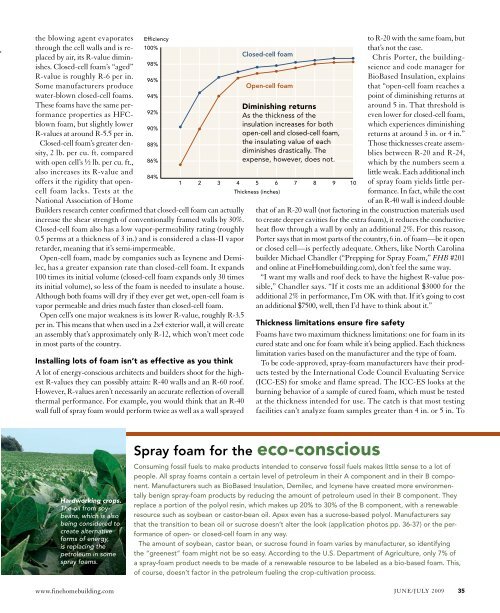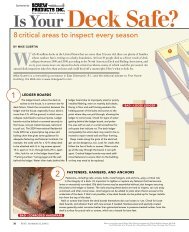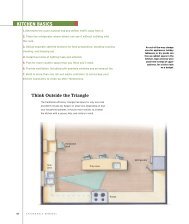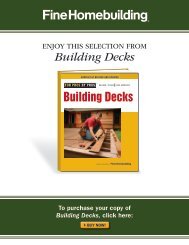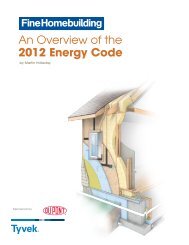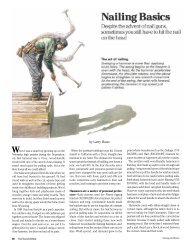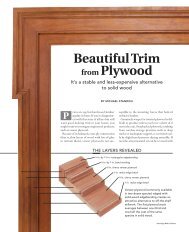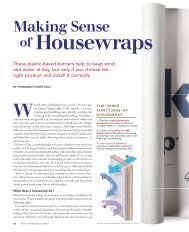Spray Polyurethane-foam Manufacturers Have A Relatively Easy
Spray Polyurethane-foam Manufacturers Have A Relatively Easy
Spray Polyurethane-foam Manufacturers Have A Relatively Easy
Create successful ePaper yourself
Turn your PDF publications into a flip-book with our unique Google optimized e-Paper software.
the blowing agent evaporates<br />
through the cell walls and is replaced<br />
by air, its R-value diminishes.<br />
Closed-cell <strong>foam</strong>’s “aged”<br />
R-value is roughly R-6 per in.<br />
Some manufacturers produce<br />
water-blown closed-cell <strong>foam</strong>s.<br />
These <strong>foam</strong>s have the same performance<br />
properties as HFCblown<br />
<strong>foam</strong>, but slightly lower<br />
R-values at around R-5.5 per in.<br />
Closed-cell <strong>foam</strong>’s greater density,<br />
2 lb. per cu. ft. compared<br />
with open cell’s 1 ⁄2 lb. per cu. ft.,<br />
also increases its R-value and<br />
offers it the rigidity that opencell<br />
<strong>foam</strong> lacks. Tests at the<br />
National Association of Home<br />
Builders research center confirmed that closed-cell <strong>foam</strong> can actually<br />
increase the shear strength of conventionally framed walls by 30%.<br />
Closed-cell <strong>foam</strong> also has a low vapor-permeability rating (roughly<br />
0.5 perms at a thickness of 3 in.) and is considered a class-II vapor<br />
retarder, meaning that it’s semi-impermeable.<br />
Open-cell <strong>foam</strong>, made by companies such as Icynene and Demilec,<br />
has a greater expansion rate than closed-cell <strong>foam</strong>. It expands<br />
100 times its initial volume (closed-cell <strong>foam</strong> expands only 30 times<br />
its initial volume), so less of the <strong>foam</strong> is needed to insulate a house.<br />
Although both <strong>foam</strong>s will dry if they ever get wet, open-cell <strong>foam</strong> is<br />
vapor permeable and dries much faster than closed-cell <strong>foam</strong>.<br />
Open cell’s one major weakness is its lower R-value, roughly R-3.5<br />
per in. This means that when used in a 2x4 exterior wall, it will create<br />
an assembly that’s approximately only R-12, which won’t meet code<br />
in most parts of the country.<br />
Installing lots of <strong>foam</strong> isn’t as effective as you think<br />
A lot of energy-conscious architects and builders shoot for the highest<br />
R-values they can possibly attain: R-40 walls and an R-60 roof.<br />
However, R-values aren’t necessarily an accurate reflection of overall<br />
thermal performance. For example, you would think that an R-40<br />
wall full of spray <strong>foam</strong> would perform twice as well as a wall sprayed<br />
Hardworking crops.<br />
The oil from soybeans,<br />
which is also<br />
being considered to<br />
create alternative<br />
forms of energy,<br />
is replacing the<br />
petroleum in some<br />
spray <strong>foam</strong>s.<br />
www.finehomebuilding.com<br />
Efficiency<br />
100%<br />
98%<br />
96%<br />
94%<br />
92%<br />
90%<br />
88%<br />
86%<br />
84%<br />
to R-20 with the same <strong>foam</strong>, but<br />
that’s not the case.<br />
Closed-cell <strong>foam</strong><br />
Chris Porter, the buildingscience<br />
and code manager for<br />
BioBased Insulation, explains<br />
Open-cell <strong>foam</strong><br />
that “open-cell <strong>foam</strong> reaches a<br />
point of diminishing returns at<br />
Diminishing returns<br />
around 5 in. That threshold is<br />
As the thickness of the<br />
even lower for closed-cell <strong>foam</strong>,<br />
insulation increases for both which experiences diminishing<br />
open-cell and closed-cell <strong>foam</strong>, returns at around 3 in. or 4 in.”<br />
the insulating value of each<br />
Those thicknesses create assem-<br />
diminishes drastically. The<br />
blies between R-20 and R-24,<br />
expense, however, does not. which by the numbers seem a<br />
little weak. Each additional inch<br />
of spray <strong>foam</strong> yields little performance.<br />
In fact, while the cost<br />
of an R-40 wall is indeed double<br />
that of an R-20 wall (not factoring in the construction materials used<br />
to create deeper cavities for the extra <strong>foam</strong>), it reduces the conductive<br />
heat flow through a wall by only an additional 2%. For this reason,<br />
Porter says that in most parts of the country, 6 in. of <strong>foam</strong>—be it open<br />
or closed cell—is perfectly adequate. Others, like North Carolina<br />
builder Michael Chandler (“Prepping for <strong>Spray</strong> Foam,” FHB #201<br />
and online at FineHomebuilding.com), don’t feel the same way.<br />
“I want my walls and roof deck to have the highest R-value possible,”<br />
Chandler says. “If it costs me an additional $3000 for the<br />
additional 2% in performance, I’m OK with that. If it’s going to cost<br />
an additional $7500, well, then I’d have to think about it.”<br />
1 2 3 4 5 6 7 8 9 10<br />
Thickness (inches)<br />
Thickness limitations ensure fire safety<br />
Foams have two maximum thickness limitations: one for <strong>foam</strong> in its<br />
cured state and one for <strong>foam</strong> while it’s being applied. Each thickness<br />
limitation varies based on the manufacturer and the type of <strong>foam</strong>.<br />
To be code-approved, spray-<strong>foam</strong> manufacturers have their products<br />
tested by the International Code Council Evaluating Service<br />
(ICC-ES) for smoke and flame spread. The ICC-ES looks at the<br />
burning behavior of a sample of cured <strong>foam</strong>, which must be tested<br />
at the thickness intended for use. The catch is that most testing<br />
facilities can’t analyze <strong>foam</strong> samples greater than 4 in. or 5 in. To<br />
<strong>Spray</strong> <strong>foam</strong> for the eco-conscious<br />
Consuming fossil fuels to make products intended to conserve fossil fuels makes little sense to a lot of<br />
people. All spray <strong>foam</strong>s contain a certain level of petroleum in their A component and in their B component.<br />
<strong>Manufacturers</strong> such as BioBased Insulation, Demilec, and Icynene have created more environmentally<br />
benign spray-<strong>foam</strong> products by reducing the amount of petroleum used in their B component. They<br />
replace a portion of the polyol resin, which makes up 20% to 30% of the B component, with a renewable<br />
resource such as soybean or castor-bean oil. Apex even has a sucrose-based polyol. <strong>Manufacturers</strong> say<br />
that the transition to bean oil or sucrose doesn’t alter the look (application photos pp. 36-37) or the performance<br />
of open- or closed-cell <strong>foam</strong> in any way.<br />
The amount of soybean, castor bean, or sucrose found in <strong>foam</strong> varies by manufacturer, so identifying<br />
the “greenest” <strong>foam</strong> might not be so easy. According to the U.S. Department of Agriculture, only 7% of<br />
a spray-<strong>foam</strong> product needs to be made of a renewable resource to be labeled as a bio-based <strong>foam</strong>. This,<br />
of course, doesn’t factor in the petroleum fueling the crop-cultivation process.<br />
juNE/july 2009 35


